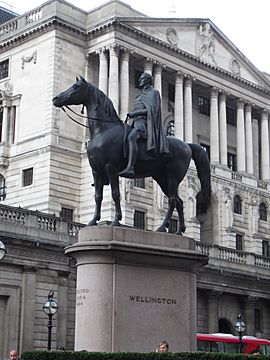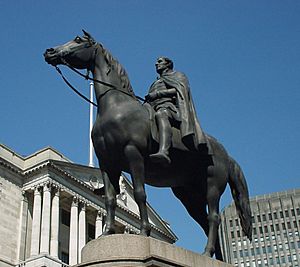Equestrian statue of the Duke of Wellington, City of London facts for kids
Quick facts for kids Equestrian statue of the Duke of Wellington |
|
|---|---|

The statue in 2014
|
|
| Artist | Francis Leggatt Chantrey |
| Year | June 18, 1844 |
| Medium | Bronze |
| Subject | Arthur Wellesley, 1st Duke of Wellington |
| Location | London |
| 51°30′39″N 0°5′16″W / 51.51083°N 0.08778°W | |
The equestrian statue of the Duke of Wellington is a famous outdoor sculpture in London, England. It shows Arthur Wellesley, 1st Duke of Wellington, who was a very important British soldier and statesman. You can find this statue at the Royal Exchange, right near Bank junction in the old City of London. The artist who created it was Francis Leggatt Chantrey. This statue was built to thank Wellington for helping the City of London rebuild London Bridge.
History of the Wellington Statue
The sculptor, Francis Leggatt Chantrey, started working on the statue. Sadly, he passed away before it was finished. His assistant, Henry Weekes, completed the sculpture.
The Duke of Wellington himself attended the statue's unveiling. This special event happened on June 18, 1844. This date was chosen because it was the anniversary of the Battle of Waterloo. In 1815, Wellington led an army to victory against Napoleon at Waterloo. Frederick Augustus II, who was the King of Saxony, was visiting Queen Victoria in London and also came to the unveiling.
About the Statue and Its Meaning
This equestrian statue was put up to show how thankful the City of London was to Wellington. He helped pass the London Bridge Approaches Act in 1827. This important law led to the creation of King William Street.
The word "Wellington" is carved on each side of the statue's base, called the plinth. On the ends of the plinth, it says "Erected June 18, 1844". A brass plaque at the bottom of the plinth explains more:
- On July 19, 1838, the City of London agreed to give £500 towards the statue. This was to thank the Duke of Wellington for his help with the London Bridge Approaches Act of 1827.
- The government gave the metal for the statue. It was bronze made from enemy cannons captured after the Battle of Waterloo. This bronze was worth £1500 at the time.
- The total cost of the statue was £9000. The rest of the money came from people donating to a public fund.
- Sir Francis Chantrey was hired in 1838 but died before finishing the work. His assistant, Henry Weekes, completed it.
- The Lord Mayor, William Magnay, officially revealed the statue on June 18, 1844. This was the anniversary of the Battle of Waterloo. The King of Saxony was also there as a guest.
- Next to the statue, a piece of granite from the old London Bridge (which stood from 1825 to 1967) has been placed in the pavement. The stone parts from that same bridge were later rebuilt in Lake Havasu City, Arizona, USA, in 1971.
See also
 In Spanish: Estatua ecuestre del duque de Wellington para niños
In Spanish: Estatua ecuestre del duque de Wellington para niños


